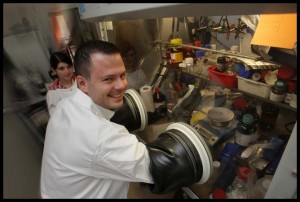Nov
10
A Better Lithium Battery
November 10, 2009 | 2 Comments
A Better Lithium Battery
Dr. Stefan Koller with his team at the Institute for Chemistry and Technology of Materials Graz University of Technology has developed a new method to utilize silicon in lithium-ion anode materials. The news stories are saying silicon applied to the anodes raises theoretical storage capacity ten times higher than the graphite substrate, which has been used up to now, and promises considerable improvements for users.
Koller, who is familiar with the research in lithium from his doctoral thesis, explains that modern electronic devices need more energy and even the automotive industry is striving for increasingly powerful energy storage systems. The technological development of battery research has been inadequate for some time now. Koller says, “A real revolution is needed for the development of the next generation. We need new storage materials for lithium-ion batteries.”
The prize to Koller, his team and the financial supporters is he has managed to develop a substrate material using silicon for electrochemical reactions at a low price.
For the process the team utilizes a silicon-containing gel and apply it to the graphite substrate material. “In this way the graphite works as a buffer, cushioning the big changes in volume of the silicon during the uptake and transfer of lithium ions,” explains Koller. Silicon if you recall, changes dimensions as it flows electrons in and out during the course of discharges and recharges and the graphite heats up, two actions that consume the energy of the battery.
The team says silicon can exploit a substantial part of theoretical lithium-ion storage capacity some ten times higher than the up-to-now commercially used graphite. The team’s new material can now store more than double the quantity of lithium ions without changes to the battery lifetime. The difference in those quantities is that the silicon is a coating over the graphite rather than a replacement.
The team’s new silicon process is far cheaper than the previous ones in which the silicon is separated in the gas phase. “The (remaining) challenge lies in the poor storage density of materials in the counter electrode in the whole battery, something which we have been doing intensive research on,” says Koller.
Should the silicon process be commercial it seems that a doubling of lithium batteries could be practical for a very low cost. Lithium is already expensive, but a doubing of capacity for a low price could reduce the lithium content perhaps by half. It seems this team’s research has a ready home. The new findings – which came to light in the “NanoPoliBat” EU project – have been recently submitted to the patent office by researchers together with their co-operation partner Varta Microbattery.
A lithium – graphite – silicon compound battery sounds good, simple and cheaper per stored watt. Lets hope the researchers get closer to the 10x mark soon.
Comments
2 Comments so far



At around $8/kg lithium is hardly expensive.
Perhaps it is the processing that is meant?
That’s awesome!